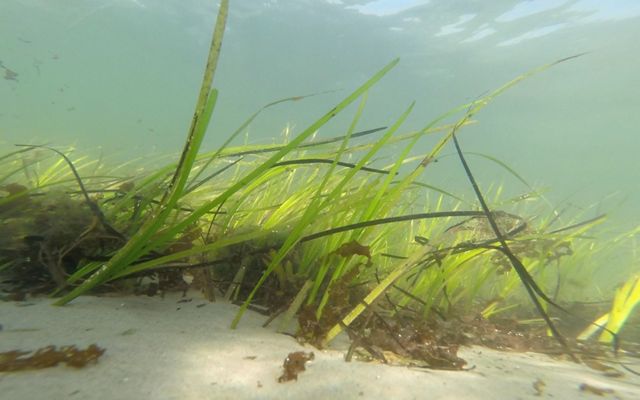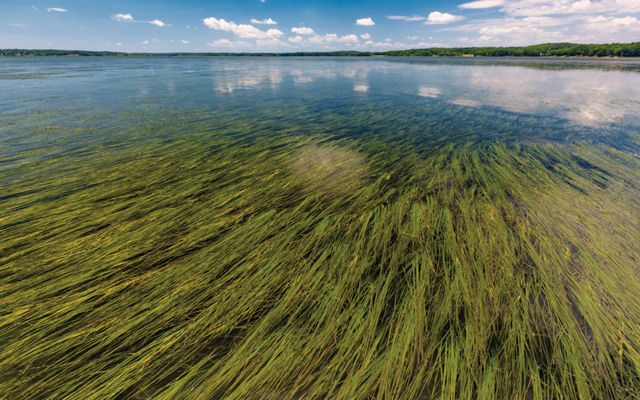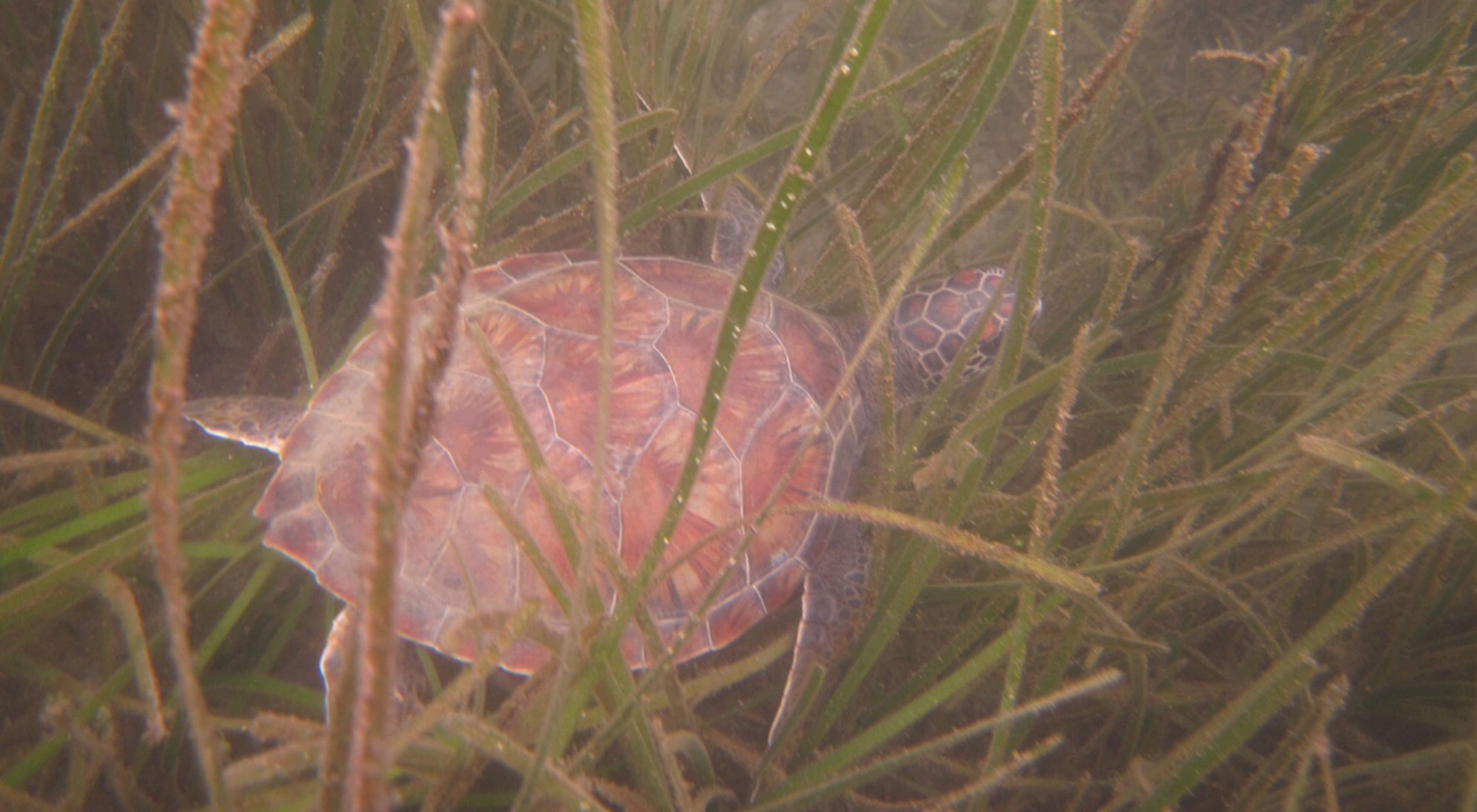Saving Seagrass
See what we're doing to protect seagrass in Long Island Sound.
A diver off Fishers Island—a roughly 4-square-mile island off the eastern end of New York’s Long Island—can encounter a mesmerizing sight: hundreds of tiny, silver-sided fish shimmering in the sunlight as a juvenile green sea turtle glides above a lush meadow of tall, waving grass blades.
Yes, it’s certainly beautiful. But the scene is also rare.
Fishers Island’s seagrass is among the last meadows remaining in Long Island Sound, which includes both Connecticut and New York waters. This meadow is exceptional for its height of up to 3 feet and the 24-foot depths to which it grows.
Seagrass meadows once fringed bays and harbors along both New York's and Connecticut’s shores, but today 90% of the seagrass is gone.
The Nature Conservancy has completed extensive research into the decline of these meadows, which provide irreplaceable benefits for marine life and people. Now TNC is working across state borders to protect the Sound’s remaining meadows—only 2,000 acres—and restore conditions required to ensure that they continue to survive and even thrive. A new partnership informed by TNC’s research and advocacy is bringing that goal closer to reality.

Why Seagrass Matters and What Happened to It
Seagrasses are a unique group of flowering marine plants that live fully submerged in shallow coastal waters around the world and provide essential habitat for thousands of ocean animals. Eelgrass (Zostera marina), the main species of seagrass found in Long Island Sound, provides habitat for species such as flounder, bay scallops and American lobster, which are commercially and recreationally important.
Seagrass meadows also provide recreational opportunities for divers, improve water quality and clarity by absorbing nutrients, and reduce shoreline erosion by stabilizing sediments. Additionally, they are an important component of coastal blue carbon, which helps mitigate climate change and its impacts by restoring critical aquatic systems that sequester carbon.
Some of the “services” seagrass provides hint at its vulnerabilities though. In response, TNC scientists began a multiyear, federally funded research initiative in 2009 to better understand the causes of seagrass decline throughout the waters of Southern New England and New York. The initiative, completed in 2014, identified nitrogen pollution—primarily from sewage and fertilizers—and warmer water temperatures as the greatest threats to seagrass populations throughout the study region.
“Reducing nitrogen pollution from human activities is the No. 1 thing we can do to help seagrass meadows thrive in Long Island Sound,” says Holly Drinkuth, TNC's director of river and estuary conservation in Connecticut. “Eelgrass is sensitive to spikes in water temperature, so we see dramatic losses in shallow bays during extended heat waves. As water temperatures continue to increase, maintaining high water quality and clarity helps ensure remaining meadows have the best possible conditions needed to recover and persist.”
Although seagrass can absorb nitrogen, too much nitrogen can fuel overgrowth of harmful algae that smothers it. Then as fertilizer reaches the coast through water runoff, it boosts algae growth even further. Likewise, while seagrass—particularly in established meadows with deep root systems—absorbs and retains carbon, seagrass that is vulnerable to degradation by warming seas is at risk of becoming a source of carbon emissions.
Also, Drinkuth says, while we know seagrass was hit hard by disease in the 1930s, today there are persistent threats associated with physical damage from activities such as anchoring, moorings, propeller scars, dredging, coastal construction and some types of fishing gear.

Protecting Seagrass: What Comes Now?
After completing research on the causes of seagrass decline, TNC scientists first shared what they learned widely with conservation partners. TNC has also continued working with existing and new organizations to protect remaining seagrass and improve water quality where meadows have been lost, especially with the Fishers Island community.
But improving water quality locally will have far-reaching effects even beyond seagrass—on biodiversity, the fishing industry, the economy, and more, and play a role in TNC's global goal of conserving nearly 10 billion acres of ocean by 2030.
Informed by TNC's eelgrass research, community-based planning efforts and advocacy, a new Long Island Sound Seagrass Management Collaborative was formed in 2023. Overseen by the Connecticut National Estuarine Research Reserve and supported by the Environmental Protection Agency’s Long Island Sound Estuary Program, the collaborative is working to review data gaps, leverage new funding opportunities and establish a shared management strategy for eelgrass recovery in both Connecticut and New York waters of Long Island Sound.
The Long Island Sound Coastal Watershed Network—formed in 2020 by TNC, Save the Sound and Citizens Campaign for the Environment—has also played a role in eelgrass efforts. The network shares project ideas and success stories of communities tackling nitrogen pollution to collaboratively address water quality challenges and connect advocates from government and NGOs to businesses and local neighborhoods.
Work being highlighted includes studies on areas with the highest use of lawn fertilizer; information campaigns for residents using such fertilizer; local efforts to upgrade onsite sewage treatment technology; legislative proposals; and appeals to companies in the fertilizer industry. Future projects include rain gardens that absorb stormwater run-off in areas of concern.
Keeping Our Promise to Fishers Island
Your support helps us continue to preserve and protect seagrass in Long Island Sound.
